West Bend, WI – Over the last 15 years, Dave Bohn has been writing down memories of his childhood, growing up on the family farm, just south of West Bend on Hwy P. He hopes his writings will preserve the often-overlooked stories of ordinary farmers and everyday farm life in rural Washington County during the Great Depression through the eyes of a local farm boy.
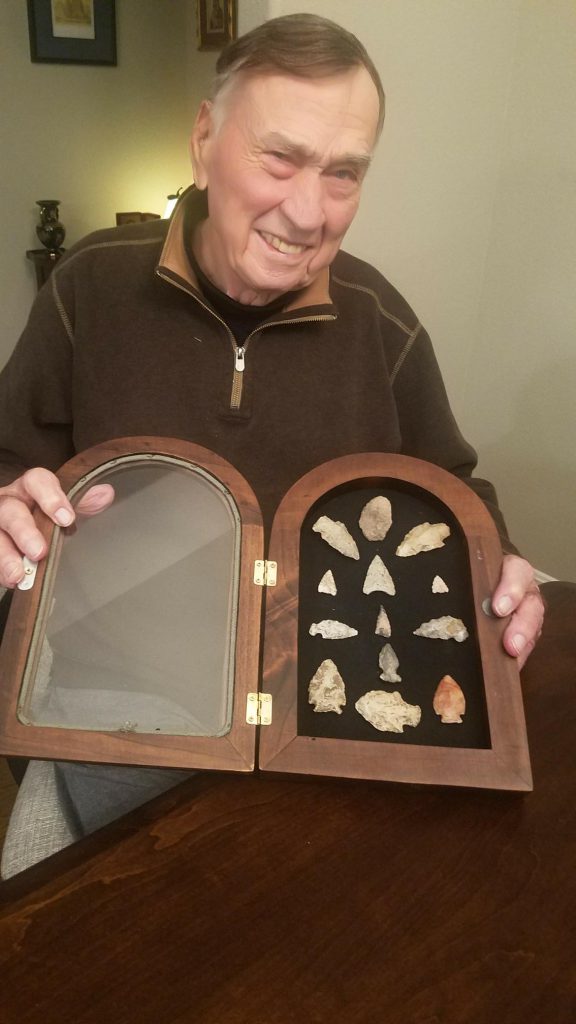
During the 1930s, when we were fairly young and still in grade school, my brother Tom, my cousin Jim Bohn, and I started looking for arrowheads. Jim was two years older than Tom and he was the one that got us going on it. I was still a little kid so I would just tag along with them. I think I may have been six or seven years old when we started.
We had some spare time in the spring between chores, so we would go looking in the farm fields of our area for Indian relics. We mainly just found stone arrowheads but Tom found a tool of some sort once and Dad found a few relics, too.
Our cousin, Jim came over to our farm a lot, so he was always along when we went out looking for arrowheads. Jim was the guy with an eye for Indian arrowheads. He always found the most. Tom had a pretty good eye, too. Out of us three, I was the worst.
Arrowheads weren’t easy to find and it was a big deal to us kids if we found one. So, we spent our free time walking up and down rows of plowed farm fields with our heads down, looking for a stone that might be an arrowhead. We became interested in finding arrowheads because Dad used to find them when he was tilling the soil. Dad found them accidentally but he would stop to pick one up if he saw one. There wasn’t big machinery back then to break up the arrowheads so you could still find them in one piece. And, at that time, the land had been worked for only a couple of generations and all by horse-drawn plows.
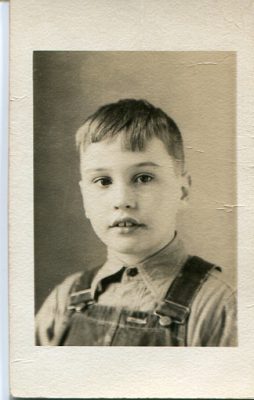
Dad would talk to us kids about the arrowheads he found. One time, Dad found a small stone bowl in the fields. He’d brought the stone bowl and the arrowheads that he found back to the house to show us. Tom recalls that Dad put the bowl on a fence post to collect water for the birds.
Click HERE to read more childhood stories by Dave Bohn
on WashingtonCountyInsider.com
Dad also found a tomahawk-like stone in the foundation of our house when they were installing the water pipe that ran from the well at the barn to the house. There was a stone foundation in our house and they had to remove a few stones to get the water pipe inside the basement.
One of the stones they removed was shaped like a tomahawk. Our house was built in 1914 but it was built on the foundation of another house that had burned down. We do know that our barn was built in 1898, so perhaps the house foundation was from around that time. It just goes to show that farmers didn’t think much if they found something in their fields at that time, as they just stuck it into the foundation. Dad kept the tomahawk-like stone though and Tom still has it.
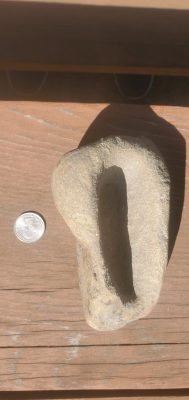
Dad would never go out looking for arrowheads but he found maybe 25 or so while working the land. Not a lot, but he wasn’t really looking for them either. That was what gave us the idea to look for them though. We had learned about Indians in school and we found proof that they had lived and hunted right near our farm. Mom didn’t care if we were out all day looking for arrowheads in spring. She probably liked having us out of her hair. She wasn’t really interested in the Indian lore of the area and while Dad didn’t talk about the Indians a lot, he did show us things he found.
Almost all farm fields had arrowheads back then. Arrowheads were found in clusters. They were mainly located where an Indian village stood at one time. Farmers would see arrowheads as they plowed the land but most farmers didn’t pick them up because they just weren’t interested in them. Only Tom, Jim, and I actually went looking for arrowheads, that we knew of.
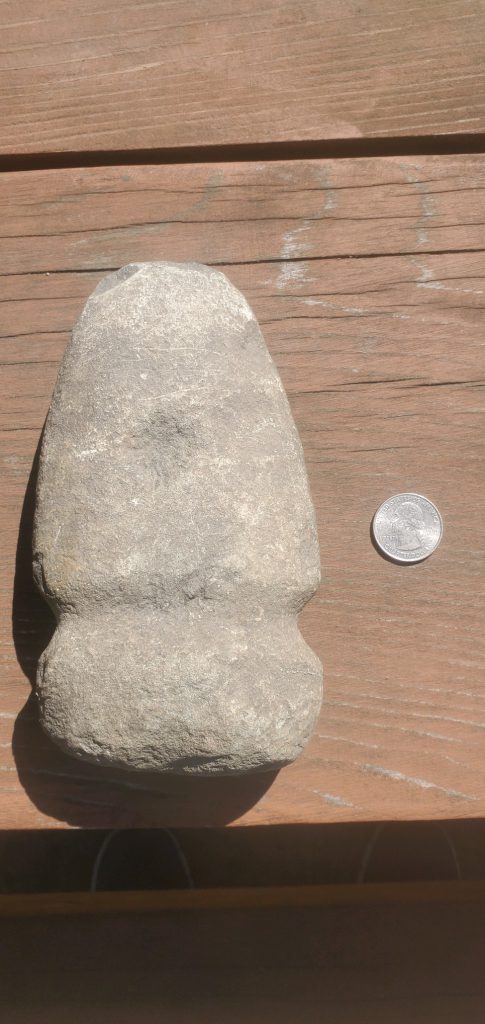
The farmers would plow their fields in the fall, digging up buried arrowheads. The snow and rain over the winter and early months of spring washed the soil from the stones after they had been exposed by the plow. In the springtime, the arrowheads would be free of dirt, laying near the top of the soil, so they were easier to spot when walking for a distance and looking at the ground for these clean stone points. Sometimes, the arrowhead was only partially exposed and we got to know if it was a real arrowhead or just another stone. Each time we went looking, we would find a couple. If we each found three arrowheads, that was a good day of looking.
We mainly found stone arrowheads, but once in a while, we would find pieces of drift copper that probably came to the area with the glaciers. My brother Tom still remembers the day he found a copper tool, which we think is a skinning knife. He was out trapping and he had crawled over a fence on our farm, near where the lower stream comes out. He looked down and saw the copper, so he stopped to pick it up. It has oxidized in the 80-plus years that he’s had it, but it was a good find. I think Jim or his brother Gene may have found a copper arrowhead in the area. I remember when I was a kid, my Uncle Frank Lorenz found a copper arrowhead in a field on his farm near the Fox River in Berlin, Wisconsin, so they were around.
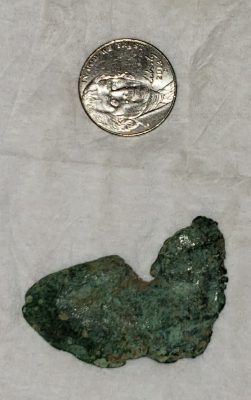
When we found an arrowhead, we just stuck it in the pocket of our bib overalls. We always wore bib overalls and it was a good place to keep our arrowheads. When we got home, we would show them to Dad. He always wanted to see them. Tom and I put the arrowheads we found in separate boxes. Tom had his, and I had mine.
We would go long distances looking for arrowheads, anywhere between our farm on Highway P and Rusco Road and the village of Cedar Creek. We walked there and back. It was a hard walk, as there was always mud in the fields in the spring. Nowadays, you would have to ask permission of the farmer to be on his land, but it was different back then.
We found most of the arrowheads near what we called Rusco Creek. There was a second creek that came from our farm that fed into Rusco Creek. Sometimes during the hot summer, the creek would dry up on our farmland, but not on the Hosp farmland, as there were several springs that fed the creek.
The water from a spring-fed creek bubbles up from the ground at all times and the water is at about 50 degrees when it bubbles up. It doesn’t freeze, even on the coldest of winter days. The Indian villages needed water year-round and they needed water to make the arrowheads, so we figured we would have our best luck in these places. And that is where the stone arrowheads and Indian tools were mostly found, in the southwest corner where those two creeks converged.
The Indians used flint to make arrowheads. Flint was a common stone in the area and plentiful to find. It is a very hard stone, so it made a good strong arrowhead. Indians would heat the flint. Once it was heated, they would drip cold water onto the flint. It must have been that with the temperature change, the flint would chip off in small pieces from the cold water or cold shock. Or maybe they took a larger stone to chip away at the flint. I really don’t know for sure. Flint would chip better than other hard stones, so it was easier to shape the arrowhead. Because it was a hard stone, the point didn’t wear down and stayed sharp longer.
There were a lot of arrowheads on the Hosp farm on the northeast corner of Rusco Road and Hwy P in the Town of West Bend. Rusco Creek ran through the farmland and some main springs were located there. At some point in time, there was an Indian village located there, which was documented by a professor maybe in the 1980s. He thought the village was on the north side of the creek, but I think it was on the south side of the creek, maybe 300 feet or so from where he thought it was. It stands to reason, as there was a sandy knoll on the creek on the Hosp farm, where I think the village was located. The sand would have provided good drainage for the village, so the land would have stayed dry and the creek and springs would have provided water.
That area was our best spot to go looking for arrowheads. We almost always found some there. I found about 100 arrowheads during my time, while my brother Tom found about twice as many and Jim found even more. Later, I would take my kids there in spring to look for arrowheads, too. The arrowheads got fewer and fewer but my kids still found some. They are probably all gone by now because the large farm equipment breaks them up.

There really weren’t Indians around when I was growing up, but my dad had known an Indian he called “Mushaway Joe.” He lived in Cedar Creek where Dad grew up on a farm. I don’t know if that was his real name, but that’s what people called him. He was the only Indian around here that I knew of when I was growing up. I don’t know much about him or whatever happened to him, as I was just a kid at the time. I heard that he didn’t want to be on an Indian reservation, so he stayed and lived in a house in Cedar Creek. I remember Dad would point him out to us when he saw him walking around.
Years later, I read in a book called The Town of West Bend by Mary and Lee Krueger that there was a Potawatomi chief named Chief Mishawa who lived with his followers on the southeast shore of Big Cedar Lake. Maybe “Mushaway Joe” was from that group of Cedar Lake Potawatomi.
I guess “Mushaway Joe” did make arrowhead points and he may have sold them at flea markets. We heard how he made his arrowheads and we did try to make them when we were kids, but we never were successful.
When my cousin Jim could drive, he would take Tom and me to arrowhead shows in the area. I remember going to the shows in Slinger and Cedar Creek. We would see “Mushaway Joe” at some of these shows. Arrowhead shows were small at that time because arrowheads were somewhat common, so people didn’t pay much care about them. They maybe sold for about 25 cents each. We never bought any. We just went to see what kind of arrowheads were there. All the arrowheads Tom, Jim and I have are arrowheads we found on the farm fields south of West Bend.
There are no two arrowheads alike. Every one is different because they were made by different people and the stone would chip differently. There were different settlements of Indians over the hundreds of years that lived here and the style of arrowheads changed over time in those different settlements. Collecting arrowheads as a kid made me interested in Indian history. Even as an adult, I am still interested.
I feel that my arrowhead collection is part of my past. When I look at my arrowheads now, my thoughts are of Indians when they were living and hunting on the land where I was born. Even though we’re both in our 90s now, Tom and I still like to talk about those days when we were boys and what we found on the farmlands of Washington County.
Comments from Washington County Insider on Facebook –
I had a service call one year for a lady that lives over by Cedar Creek just up the road from Bibinger‘s. She told me of a family journal that they found in their ancestral house that stated the family wouldn’t let the women go out after 5 o’clock at night by the creek because Indians would be running up and down the river with horses doing some kind of fishing(?) ~ Davey Jacak
My grandpa George Brugger Sr. had a knife that Joe the Indian made in Cedar Creek. ~ Bill Brugger
This brings back memories of my mom walking through a freshly worked-up field. We lived and I grew up in Farmington. And she would come home with arrowheads. It’s a vision you need to see the shape and or color. I couldn’t but mom had the gift. It is a gift. She also found a large ax head made of stone. Thanks for the flood of memories. ~ Larry Wilkins
Very interesting…we have some arrowheads too which we found on my mom and dad’s farm which was the Hosp farm. Good job Dave for all your writings. ~Darlyne Rauh
It was easier to find them when they used the furrow plows and it’s just harder now with the chisel plows. ~Steven Gebhard










